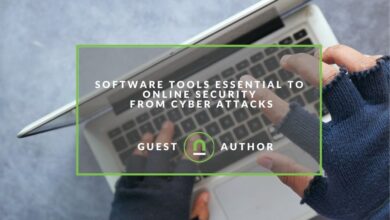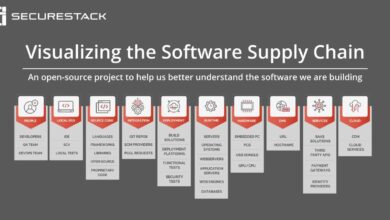
CISA Lists Out Free Cybersecurity Tools and Services
CISA lists out free cybersecurity tools and services – that’s a headline that grabbed my attention! Seriously, who wouldn’t want free, top-notch cybersecurity help? This isn’t just some fly-by-night operation either; we’re talking about the Cybersecurity and Infrastructure Security Agency, a US government agency dedicated to protecting our digital world. They’ve compiled a treasure trove of resources, from vulnerability scanners to training materials, all designed to help individuals and organizations bolster their defenses.
I dove headfirst into exploring these offerings, and let me tell you, it’s a game-changer.
This post breaks down CISA’s free cybersecurity tools and services, categorized for easy browsing. We’ll look at some specific tools in detail, compare them to other free resources, and even explore how different organizations can leverage these tools to solve real-world cybersecurity challenges. Get ready to level up your cybersecurity game – for free!
Introduction to CISA’s Free Cybersecurity Resources
The Cybersecurity and Infrastructure Security Agency (CISA) is a vital agency within the U.S. Department of Homeland Security. Its primary mission is to proactively defend against and mitigate cybersecurity threats to the nation’s critical infrastructure and the broader digital ecosystem. This involves working closely with both public sector entities, such as government agencies, and private sector organizations, including businesses of all sizes and essential service providers.CISA’s commitment to providing free cybersecurity tools and services is a cornerstone of its mission.
This initiative recognizes that robust cybersecurity isn’t just a matter for large corporations or specialized government agencies; it’s a shared responsibility that requires accessible resources for everyone. By offering these free resources, CISA aims to level the playing field, empowering organizations of all sizes and individuals to enhance their cybersecurity posture and better protect themselves from increasingly sophisticated cyberattacks.
The availability of these resources dramatically increases the collective cybersecurity resilience of the nation.
CISA’s Role in Providing Cybersecurity Resources
CISA’s involvement in providing cybersecurity resources has evolved significantly since its inception. Initially focused on critical infrastructure protection, the agency’s mandate expanded to encompass a broader range of cybersecurity threats and vulnerabilities. This expansion led to the development and dissemination of a wide array of free tools and services, reflecting a proactive approach to national cybersecurity. This proactive strategy has proven instrumental in mitigating the impact of large-scale cyberattacks, such as ransomware outbreaks, and in assisting organizations in recovering from such incidents.
The evolution reflects a growing understanding of the interconnected nature of cybersecurity and the need for a collaborative approach to address shared challenges. The free resources are a crucial element of this collaborative strategy, fostering a culture of proactive cybersecurity preparedness.
Categorization of CISA’s Free Tools and Services

CISA (Cybersecurity and Infrastructure Security Agency) offers a valuable suite of free cybersecurity tools and services designed to bolster the defenses of organizations of all sizes. Effectively utilizing these resources requires understanding their organization and functionality. This section categorizes CISA’s offerings to provide a clearer picture of their capabilities and how they can be integrated into a comprehensive cybersecurity strategy.
The categorization presented below is based on the primary function and intended use of each tool or service. While some tools might overlap categories, the primary focus determines their placement. This approach aims to provide a practical and user-friendly guide for navigating the available resources.
Categorization of CISA’s Free Tools and Services by Functional Area
The following table organizes CISA’s free tools and services into logical categories, providing examples and links where available. Note that the specific tools and services offered by CISA can change over time, so it’s always best to check their official website for the most up-to-date information.
| Category | Tool/Service Name | Description | Link (if available) |
|---|---|---|---|
| Vulnerability Management | National Vulnerability Database (NVD) | A repository of standardized vulnerability information, enabling organizations to identify and prioritize security risks. | https://nvd.nist.gov/ |
| Incident Response | Cybersecurity Tip Sheet | Provides practical guidance and best practices for handling various cybersecurity incidents. | (Link varies depending on the specific tip sheet; check CISA website) |
| Awareness Training | Stop.Think.Connect. Campaign | A public awareness campaign providing resources and information to educate individuals about cybersecurity threats. | https://www.dhs.gov/stopthinkconnect |
| Security Assessments | Self-Assessment Tools (Various) | Provides questionnaires and checklists to help organizations assess their cybersecurity posture. Specific tools vary. | (Check CISA website for specific tools) |
| Threat Intelligence | Alerts and Advisories | CISA regularly publishes alerts and advisories on emerging threats and vulnerabilities. | https://www.cisa.gov/alerts |
| Software and System Security | Guidance on Secure Software Development | Provides best practices and recommendations for developing and deploying secure software. | (Check CISA website for specific guidance documents) |
Comparison of CISA’s Tool Categories
The categories of tools and services offered by CISA represent different, yet interconnected, aspects of cybersecurity. Vulnerability management focuses on proactively identifying and mitigating weaknesses, while incident response addresses the aftermath of a successful attack. Awareness training empowers individuals to be the first line of defense, while security assessments provide a snapshot of an organization’s overall security posture.
Threat intelligence keeps organizations informed of emerging threats, enabling proactive defenses. Software and system security provides best practices for the development of secure software.
The effectiveness of CISA’s offerings relies on their integrated use. For example, vulnerability information from the NVD can inform security assessments, leading to improved mitigation strategies. Similarly, incident response plans can be strengthened by incorporating lessons learned from threat intelligence and awareness training programs.
Detailed Examination of Specific CISA Tools
CISA offers a treasure trove of free cybersecurity tools and services, but navigating the options can be daunting. This section dives deeper into three specific tools, showcasing their capabilities and practical applications. We’ll examine their strengths and weaknesses, highlighting how they can improve your organization’s security posture.
Continuous Diagnostics and Mitigation (CDM), Cisa lists out free cybersecurity tools and services
The Continuous Diagnostics and Mitigation (CDM) program provides a suite of tools and services designed to enhance federal agency cybersecurity. While primarily targeted at government entities, many of its principles and underlying technologies are applicable to private sector organizations. Its core function is to improve the visibility and security posture of an organization’s IT infrastructure. The target audience is primarily IT administrators and security professionals responsible for managing and securing large and complex IT environments.Key features include automated vulnerability scanning, security information and event management (SIEM) capabilities, and asset inventory management.
These tools allow for proactive identification of security gaps, real-time threat detection, and comprehensive monitoring of network activity.Benefits include improved threat detection and response, reduced risk exposure, and better compliance with security regulations. Potential limitations include the program’s primary focus on federal agencies, requiring some adaptation for private sector use, and the need for skilled personnel to effectively utilize and interpret the data provided.
In a real-world scenario, a financial institution could leverage CDM’s vulnerability scanning capabilities to proactively identify and patch critical vulnerabilities in its banking applications, mitigating the risk of data breaches and financial loss.
National Vulnerability Database (NVD)
The National Vulnerability Database (NVD) is a repository of standardized vulnerability information. It serves as a centralized source for information on publicly known security vulnerabilities and exposures (CVE). Its primary function is to provide a comprehensive and consistently formatted catalog of vulnerabilities affecting various software and hardware products. The target audience is broad, encompassing security researchers, software developers, IT administrators, and anyone concerned with cybersecurity.Key features include detailed vulnerability descriptions, Common Vulnerabilities and Exposures (CVE) identifiers, severity scores (CVSS), and associated remediation advice.
The NVD’s standardized format ensures consistent and comparable information across different sources.The benefits are numerous: improved vulnerability awareness, faster response times to emerging threats, and more effective risk management. Limitations include the potential lag between vulnerability discovery and inclusion in the NVD, and the reliance on the community to report vulnerabilities. A software development team could use the NVD to identify vulnerabilities in third-party libraries used in their application, allowing them to proactively update their code and prevent exploitation.
ICS-CERT Alert and Advisory System
The Industrial Control Systems Cyber Emergency Response Team (ICS-CERT) Alert and Advisory System focuses specifically on industrial control systems (ICS) cybersecurity. Its primary function is to provide timely warnings and guidance on emerging threats targeting critical infrastructure. The target audience is primarily organizations operating critical infrastructure, including power grids, water treatment facilities, and manufacturing plants.Key features include alerts on specific vulnerabilities and attack vectors affecting ICS, advisories on best practices for securing ICS environments, and incident response guidance.
The system prioritizes timely dissemination of information to protect vulnerable systems.Benefits include enhanced situational awareness, proactive mitigation of potential threats, and improved incident response capabilities. Potential limitations include the highly specialized nature of the information, requiring a deep understanding of ICS environments, and the need for organizations to adapt the advice to their specific contexts. A power utility company could use ICS-CERT alerts to quickly identify and address vulnerabilities in their SCADA systems, preventing potential disruptions to power generation and distribution.
Assessing the Impact and Effectiveness of CISA’s Resources: Cisa Lists Out Free Cybersecurity Tools And Services
CISA’s freely available cybersecurity tools and services represent a significant investment in bolstering the nation’s overall cybersecurity posture. Their impact is multifaceted, ranging from providing essential resources to small businesses lacking dedicated IT staff to supporting large organizations in enhancing their security defenses against sophisticated threats. Evaluating this impact requires examining both direct successes and areas for potential improvement.The effectiveness of CISA’s resources is demonstrably linked to their adoption and proper utilization.
While quantifying the exact impact on reducing nationwide cyber incidents is challenging, anecdotal evidence and case studies reveal significant positive contributions.
Successful Deployments and Positive Outcomes
Several successful deployments showcase the tangible benefits of CISA’s resources. For instance, the adoption of CISA’s vulnerability scanning tools by smaller businesses has led to the identification and remediation of critical vulnerabilities before they could be exploited by malicious actors. This proactive approach has demonstrably reduced the likelihood of successful ransomware attacks and data breaches, saving these businesses significant financial and reputational losses.
Similarly, the use of CISA’s incident response guides has assisted organizations in effectively containing and mitigating the impact of cyberattacks, minimizing downtime and data loss. The increased awareness and training materials provided by CISA have also empowered individuals and organizations to better understand and defend against phishing attacks and other social engineering tactics. These examples highlight the direct, positive impact of CISA’s readily available resources.
Areas for Improvement Based on User Feedback and Emerging Threats
User feedback consistently points to a need for improved documentation and more user-friendly interfaces for some of CISA’s tools. Streamlining the access and integration of these tools into existing security infrastructure would also enhance their effectiveness. Furthermore, as the threat landscape continues to evolve, CISA must adapt its offerings to address emerging threats such as AI-powered attacks and the increasing sophistication of ransomware.
This requires continuous updates and the development of new tools and resources to counter these evolving threats. Regular user surveys and feedback mechanisms can provide valuable insights for prioritizing future development efforts.
Challenges in Disseminating and Supporting Free Resources
Despite the value of CISA’s resources, disseminating and providing effective support for these free tools presents challenges. Reaching and engaging a broad range of users, from technically proficient IT professionals to less technically skilled individuals, requires a multi-pronged approach. This includes targeted outreach programs, effective training materials, and readily available technical support. Furthermore, maintaining and updating the tools requires ongoing investment and resources, ensuring their continued relevance and effectiveness in the ever-changing cybersecurity environment.
Funding limitations and staffing constraints could hinder CISA’s ability to fully address the growing demand for its services. Effective resource allocation and strategic partnerships could help mitigate these challenges.
Comparison with Other Free Cybersecurity Resources
CISA’s suite of free cybersecurity tools and services is a valuable resource for organizations of all sizes, but it’s important to understand how it stacks up against similar offerings from other reputable organizations. A comparative analysis helps determine the best fit for specific needs and highlights potential areas for collaboration and improvement across the cybersecurity landscape. This section will explore the relative strengths and weaknesses of CISA’s resources when compared to those provided by NIST and the SANS Institute.
While CISA, NIST, and SANS all offer valuable free cybersecurity resources, their focus and approach differ significantly. CISA emphasizes practical, immediately actionable tools and guidance tailored to addressing current threats faced by government and private sector organizations. NIST, on the other hand, provides a more comprehensive and foundational approach, focusing on standards, frameworks, and best practices for building a robust cybersecurity posture.
SANS, known for its training and research, offers a blend of practical tools, educational resources, and research reports focused on specific technical areas within cybersecurity.
Key Differentiators Between CISA, NIST, and SANS Resources
The following points highlight the key differences in the types of resources offered, their intended audience, and their overall approach to cybersecurity:
- Focus: CISA focuses on immediate threat mitigation and actionable guidance; NIST emphasizes standards and frameworks for long-term cybersecurity posture; SANS focuses on in-depth technical training and research on specific security topics.
- Audience: CISA resources are broadly applicable to both public and private sectors; NIST resources are often geared towards organizations developing comprehensive cybersecurity programs; SANS resources target security professionals seeking advanced training and expertise.
- Resource Types: CISA provides tools, alerts, and guidance documents; NIST offers frameworks (e.g., NIST Cybersecurity Framework), standards (e.g., NIST SP 800-series), and publications; SANS offers online courses, webcasts, and research papers.
- Implementation: CISA resources are often designed for quick implementation; NIST resources require a more strategic and planned approach; SANS resources are valuable for professional development and enhancing technical skills.
Potential for Collaboration and Synergy
Despite their differing focuses, significant synergy exists between CISA, NIST, and SANS. Collaboration could lead to improved cybersecurity outcomes for all organizations. For example, CISA could leverage NIST frameworks to inform its guidance and tools, ensuring alignment with widely accepted best practices. Similarly, incorporating SANS research findings into CISA’s threat alerts could enhance the timeliness and relevance of its warnings.
CISA’s list of free cybersecurity tools and services is a fantastic resource, especially for smaller businesses. But robust security needs equally robust application development, which is why I’ve been exploring the exciting advancements in domino app dev, the low-code and pro-code future , to build secure and efficient systems. Ultimately, combining these free security tools with a well-built application is key to a strong cybersecurity posture.
Such collaborative efforts would improve the overall effectiveness of free cybersecurity resources available to the public.
Illustrative Scenarios of CISA Resource Utilization

CISA offers a wealth of free cybersecurity resources, and their effectiveness is best understood through practical application. The following scenarios demonstrate how organizations of different sizes and sectors can leverage these tools to address specific vulnerabilities and improve their overall security posture. Each scenario highlights the challenges faced, the CISA resources employed, and the positive outcomes achieved.
Small Business: Protecting Against Phishing Attacks
A small bakery, “Sweet Success,” with ten employees, experienced a phishing attack targeting their email accounts. The attackers successfully compromised one employee’s account, gaining access to customer data and financial information. Sweet Success lacked robust security awareness training and lacked a centralized system for detecting phishing attempts. To mitigate future risks, they utilized CISA’s resources, specifically the “Stop.Think.Connect.” campaign materials to educate their employees on identifying and reporting phishing emails.
They also implemented the free email security assessment tool offered by CISA, which identified weaknesses in their email filtering and authentication protocols. By implementing the recommended security improvements and providing regular training using CISA’s materials, Sweet Success significantly reduced the likelihood of future successful phishing attacks and improved their employees’ security awareness. The outcome was a strengthened security posture and increased employee confidence in identifying and reporting potential threats.
Large Enterprise: Enhancing Vulnerability Management
“TechCorp,” a large technology firm with hundreds of employees and a complex IT infrastructure, needed to improve its vulnerability management program. They faced challenges in identifying and remediating vulnerabilities across their vast network. TechCorp leveraged CISA’s vulnerability scanning tools and the NIST Cybersecurity Framework to assess their current security posture and identify critical vulnerabilities. The detailed reports provided by CISA’s tools helped prioritize remediation efforts, focusing on high-risk vulnerabilities first.
CISA’s list of free cybersecurity tools is a fantastic resource, especially for smaller businesses. But even with those freebies, understanding the complexities of cloud security is crucial, which is why I’ve been diving into resources like this article on bitglass and the rise of cloud security posture management lately. It’s amazing how much you can bolster your security, even with free tools, once you have a solid grasp of modern threats like those targeting cloud environments.
Back to CISA’s list though – definitely worth checking out!
By systematically addressing the identified vulnerabilities using CISA’s guidance, TechCorp significantly reduced their attack surface and strengthened their overall security posture. The result was a more resilient infrastructure, better equipped to withstand sophisticated cyberattacks. The NIST Cybersecurity Framework provided a structured approach to managing risks and prioritizing remediation efforts.
Government Agency: Improving Incident Response Capabilities
A local government agency, responsible for managing citizen data, experienced a data breach resulting from a compromised server. The agency lacked a formal incident response plan and struggled to effectively contain and investigate the breach. To improve their incident response capabilities, the agency utilized CISA’s incident response resources, including playbooks and best practices guides. They also participated in CISA’s training programs for incident responders, enhancing their team’s skills and knowledge.
The agency developed a comprehensive incident response plan based on CISA’s guidance, including clear procedures for detection, containment, eradication, recovery, and post-incident activity. The improved response plan, combined with enhanced staff training, allowed the agency to respond more effectively to future incidents, minimizing the impact of potential breaches and strengthening their ability to protect sensitive citizen data. The implementation of CISA’s recommended practices led to a significant improvement in the agency’s preparedness and response capabilities.
Conclusion

So, there you have it – a glimpse into the fantastic world of free cybersecurity resources offered by CISA. From vulnerability management to incident response training, CISA offers a comprehensive suite of tools designed to strengthen our collective digital defenses. While no single solution is a silver bullet, the accessibility and quality of CISA’s offerings make a significant difference.
Remember, staying informed and proactive is key in the ever-evolving landscape of cybersecurity. Take advantage of these free resources, and let’s work together to build a more secure digital future!
General Inquiries
What is CISA?
CISA, the Cybersecurity and Infrastructure Security Agency, is a US government agency responsible for protecting critical infrastructure and national cybersecurity.
Are these tools only for US citizens/organizations?
While primarily focused on the US, many of CISA’s resources are applicable globally and benefit anyone concerned with cybersecurity.
How often are the tools and services updated?
CISA regularly updates its resources to address emerging threats and vulnerabilities. Check the individual tool pages for the most current information.
Is technical expertise required to use these tools?
The level of technical expertise needed varies depending on the specific tool. Some are user-friendly, while others may require more advanced skills.





